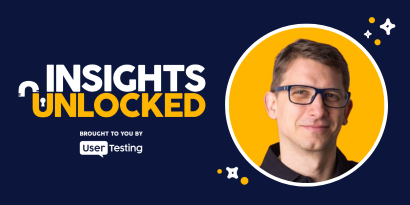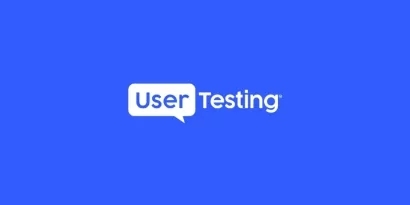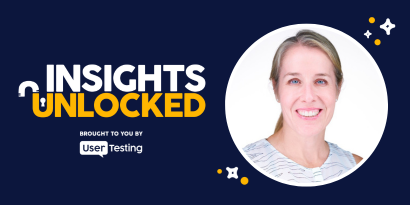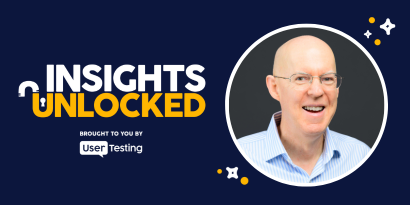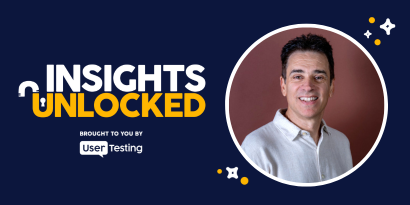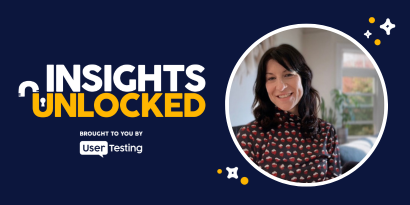
Episode 114 | April 22, 2024
What to consider when designing your augmented future
In this Insights Unlocked episode, UserTesting’s Andy MacMillan talks with Lookout's David Rose about designing our augmented realities and what UX designers, product leaders and others should consider as they take on that challenge.
What to consider when designing your augmented future
David Rose’s tech-inspired inventions help millions of people every day, from knowing what medicines to take to navigating your boat.
"My aim is always to create things that feel natural and like they were meant to be there all along, because they're kind of part of the furniture or fabric of your life," he said.
David is an award-winning, six-time entrepreneur across a range of industries from healthcare to toys to tech. He is an international speaker; patent holder; MIT researcher; and the author of two books: Enchanted Objects, which was about the internet of things; and SuperSight about augmented reality and its role in our lives. He’s also the CEO at Lookout, the AI camera system for safe navigation on the water.
In this Insights Unlocked episode, UserTesting’s Andy MacMillan talks with David about designing our augmented realities and what UX designers, product leaders, and others should consider as they take on that challenge.

David shares his passion for integrating technology into everyday objects to enhance user experience without overwhelming it. He explains how technologies like IoT and AR can be seamlessly incorporated into daily life, making technology feel as though it has always been a part of our environment. For instance, his invention, GlowCap, helps users manage their medication intake through a simple cap on medicine bottles, avoiding the need for a more intrusive app-based solution.
Bringing augmented reality (AR) and AI to marine navigation
A factoid for your next networking event: compared to driving, boating is 13 times more dangerous per hour. Think of all the possible things that could go wrong: running aground, hitting another boat, getting hit by another boat, someone going overboard, hitting debris in the water; knowing who has the right of way and so forth.
A new set of tools for creating in spatial computing
For UX designers and product managers, David’s insights are invaluable. He discusses the importance of designing with the user in mind, ensuring that technology solutions are not only effective but also enjoyable to use.
He said UX designers will need to learn a new set of tools for creating in spatial computing, and that the UX for spatial computing will be very different from the mobile tools to which we have become accustomed.
“I'm thinking especially about how we distribute content and experiences that are in the physical world all around us,” he said, adding that his book SuperSight includes a set of design principles for spatial computing.
“The thing that UX designers need to consider when designing AR experiences or VR experiences is it usually has to do with augmenting things that are tangible in the world,” he said.
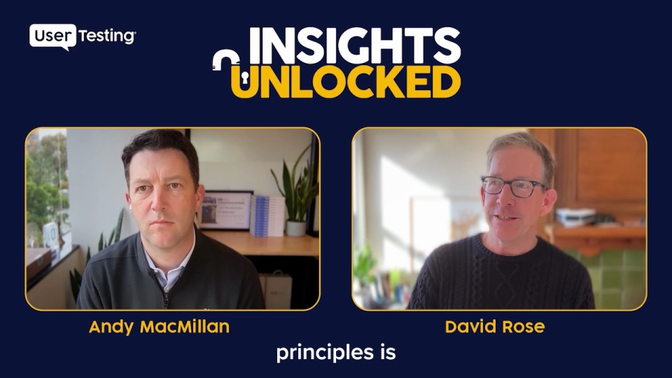
He used the example of Curiscope, which has a kid’s t-shirt with a QR code on it that, when scanned, allows you to see the circulatory and respiratory systems of the kid. “So you hold up your phone and it looks like you can see the open chest of the person. You're anchoring something into the context of literally the inside of the chest.”
The six hazards with augmented reality
David has identified six hazards that could arise from adopting AR/VR and other enhanced reality devices, from equity and access issues to social isolation. He also introduces some actionable ways to address the risks. The six hazards include:
- Social isolation
- State of surveillance
- Cognitive crutches
- Ad model
- Training bias
- Pervasive persuasion
To illustrate one example, he talks about his experience with one of the new VR headsets to come on the market. He said he returned it, not because anything was bad with it but because “I just didn't feel like it was good for my marriage and my relationship with my kid,” he said.
And that isolation, he said, “destroyed the common media experience that I could have at the end of the day with my kid. It was mostly a media consumption tool that isolated me.”
Andy shared a similar experience with wearing a headset that simulated watching a movie alone in a theater. “But the weird part was you're in an empty movie theater and you're the only person in there. I don't think I would pay extra to sit in a movie theater by myself.”
But that is “maybe different than when I'm on an airplane, which might be the right use case, which is I often don't want to be sitting with the people with me on the airplane,” Andy said. “So maybe that's where VR will really take off.”
How is user experience and customer insights shaping how AR products are developed?
David stresses the necessity of a user-centered design approach, which considers how real people will interact with products in their everyday lives.
“One of the insights that happened at Warby Parker when we're doing the virtual try on app was that our first instinct was to make it a separate experience. And then we realized the best way to use it was to make it episodic,” David said.
He said they decided to make it a feature of something else people were already doing. So you would search the eyeglass frames catalog on your phone, and then you’d just pull down this card in order to see yourself wearing the glasses.That would trigger the front facing camera and it would put the glasses on your face.
But, he said, they left a tip of the card visible so that it was easy to get into it and get out of it. “Many people used it and loved it and would share that on social media,” David said. “And they would come into the store and they would say, ‘Well, these are the ones I tried online, and here's my dance card for what I want to see actually on my face.’”
“And that made me understand that as a designer, we really need to have humility,” he said. “The AR experience won't be everything. You'll still have other browsing experiences. And people at the end of the day will still want to go into the store and still want to share selfies of themselves with their friends, even after they go to the store in order to make a decision about glasses.
And it's just part of a customer journey that's what I call multi-channel zigzag, where you want to try it in real life, and then you want to try it online, and then maybe back to real life before you make a decision. And I think we can see that happening across lots of other product categories too.”
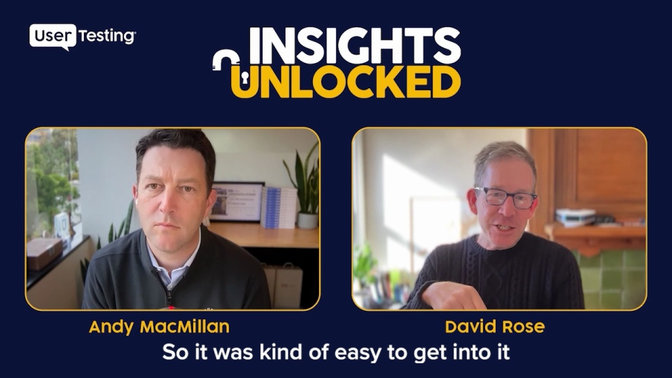
Is it tech-led product development or problem-led?
Whether it is AR/VR, AI or machine learning, or whether it is deployed digitally or in real life, or some combination of all of the above; technology keeps advancing and costs are not the entry barriers they once were. Andy asked David what should designers, product teams, organizations, or prospective founders consider as they look at the world around them? Should they be tech-led or problem-led when it comes to product development?
“To me, it's an oscillation back and forth between being problem led and being tech led,” David said. “Many times the inspiration comes from a tech because you don't or you can't really understand the potential of solving a problem until you sometimes see a tech.”
For example, at Lookout, they’re doing a lot with near-infrared and thermal imaging to help safeguard against hitting whales and other mammals below the surface or helping rescue people who fall overboard.
“I knew that the problem of not hitting whales or wildlife in the water was a problem, but it wasn't until I learned about thermal imaging that I realized we could get a thermal imaging system and put that in our camera system so that so we could help solve the problem of people hitting wildlife when they're going too fast,” David said.
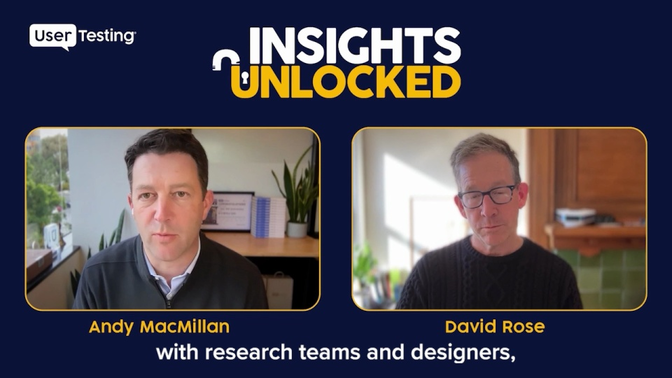
Andy agreed with the idea of oscillating back and forth. “As we work with research teams and designers, I think people really like to categorize things and take these very strict approaches,” Andy said. “And I like this idea of you can sort of move back and forth as you learn about a technology that you put it in your interesting idea space, but then you oscillate over to a problem set. You're working on a sort of back and forth.”
Episode links
- David on LinkedIn
- Andy on LinkedIn
- Lookout website
- Book: SuperSight: What Augmented Reality Means for Our Lives, Our Work, and the Way We Imagine the Future
- Book: Enchanted Objects: Innovation, Design, and the Future of Technology
- UserTesting’s metaverse and virtual reality (VR) testing template
- Glossary: What is mobile testing?
- Blog: Effective UX Research for Wearable Devices
